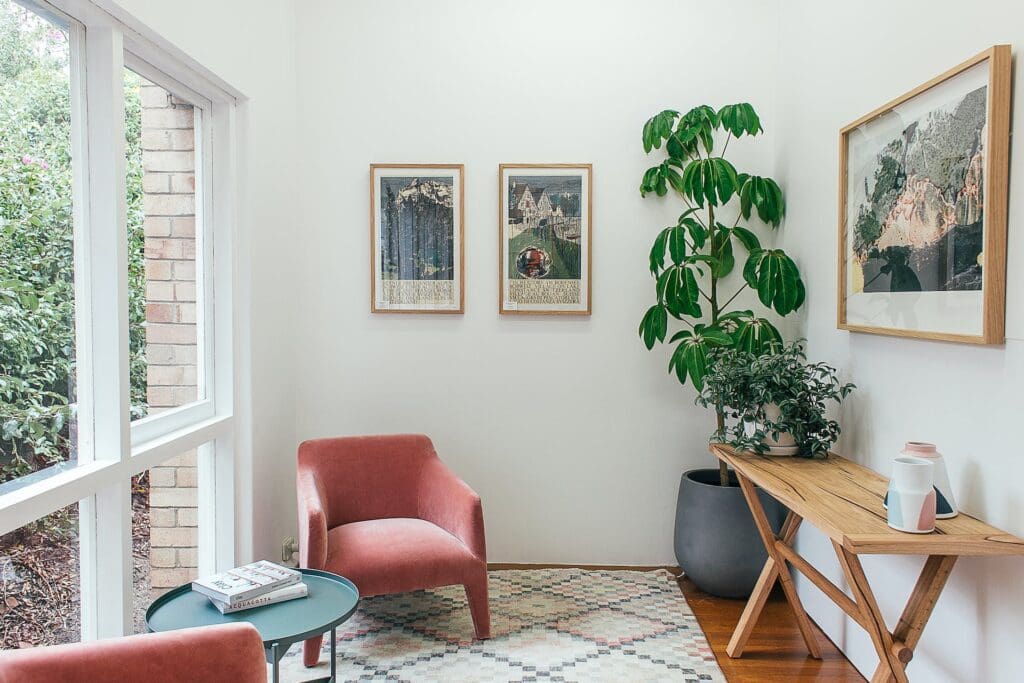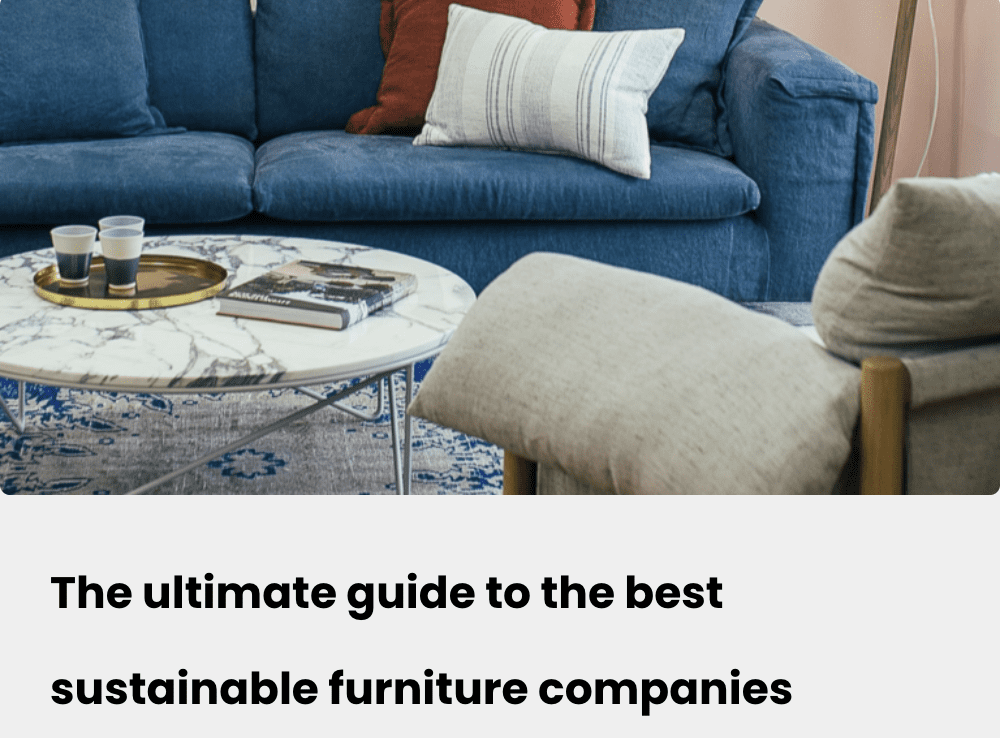In this post, we share ideas about holistic interior design, an interior design philosophy that considers the way a space impacts the health and well-being of those in it.
The Home Green is reader-supported and may receive a commission if you decide to make a purchase through a posted link, at no cost to you.
There's a popular notion that interior design is primarily about luxury and status, but that’s a narrow view of a very diverse field. Focusing on the design of your home can, in fact, be a way to make it a healthier place to live. That’s exactly the focus on holistic interior design. It goes beyond just how a space looks to how you feel in that space.
What is holistic interior design, exactly?
The goal of holistic interior design is create a space that has a positive impact on physical, mental, and emotional health of the people in it. Because of this focus on health, holistic interior design is sometimes called wellbeing interior design – it’s a focus on creating spaces that support a person’s overall quality of life.
How does holistic interior design come to life? Here are some of the key elements:
Connectivity to nature
Holistic design seeks to create a connection to the natural world, whether through the use of natural materials, views of nature, or incorporating natural elements into each design.
Energy flow and balance
In holistic design, there is often an emphasis on the flow of energy within a space, with the goal of creating a harmonious and balanced environment.
Function and efficiency
Holistic interior design also considers the practical aspects of a space, ensuring that it functions well and meets the needs of the occupants.
Personalization
Holistic interior design should take into account the individual needs and preferences of the people who live in the space. The most successful holistically designed spaces reflect the lifestyle and personality of the people who will use them.
Sustainability
It’s not surprising that there is overlap between sustainable interior design and holistic interior design – what’s good for people is so often also good for the planet! Both involve the use of environmentally friendly, non-toxic materials, energy-efficient systems, and waste reduction.
Mindfulness
Holistic design emphasizes creating spaces that promote mindfulness and a sense of tranquility. This can be achieved through the use of plants and natural light, as well as the creation of spaces that encourage relaxation and stress reduction.
How to apply holistic design ideas in your home
Expert holistic design advice from Gala Magriñá, founder of Gala Magriñá Design


We reached out to holistic interior design expert and pioneer, Gala Magriñá, founder of Gala Magriñá Design, who shares her recommendations on the top 3 ways that you can incorporate holistic design principles into your own home.
1) Feng Shui and the language of space
One aspect of Feng Shui involves energy flowing freely throughout the home. One way to ensure your space flows is to get rid of clutter. Clutter represents the past, holding onto emotional baggage, heaviness and creates stagnant energy and blockages in our space. When we de-clutter we create space for new things and opportunities to come into our lives and energy to flow freely throughout our home which results in a feel good space.
2) Light
We should be getting at least 30 minutes of natural light a day. Try and make sure that if you have a WFH office that it gets natural light. As the sun moves through the sky throughout the day it changes color and this change affects our circadian rhythms which in turn affect our moods. So it’s important to try and stay connected to the sun’s light throughout the day- even while indoors.
3) Colors
We are reacting to color vibrations all the time – even while we are asleep! Not only do we take color vibrations in through our eyes, but also through our skin. Color is a powerful force that can be used to help heal, relax and to aid in learning and stimulating the mind, so it’s important to figure out what colors resonate with you and use them in your spaces. Bright colors like yellow and orange are more stimulating and good for office areas and breakfast nooks while softer, warm colors, like lavender, rose, and pale yellow are best for relaxation.
Examples of holistc interior design from Gala Magriñá Design
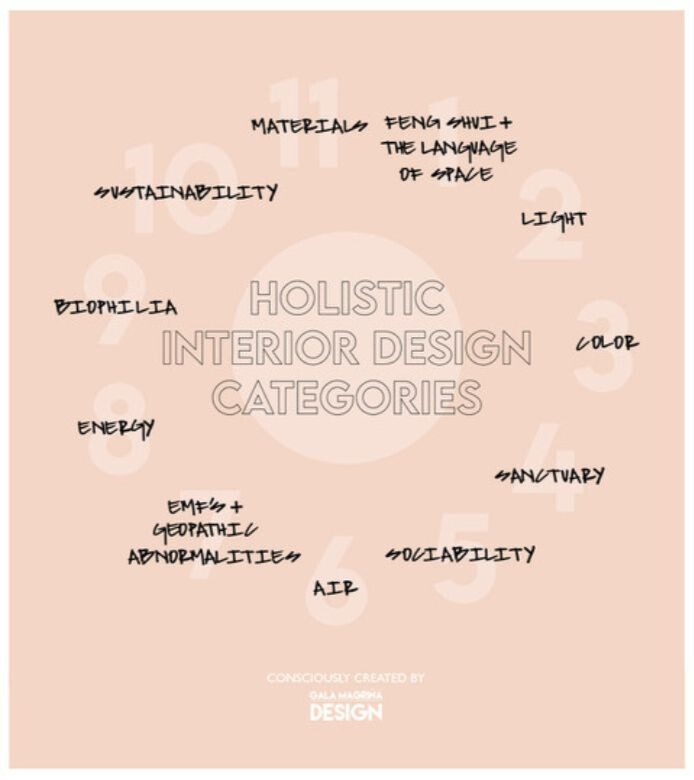

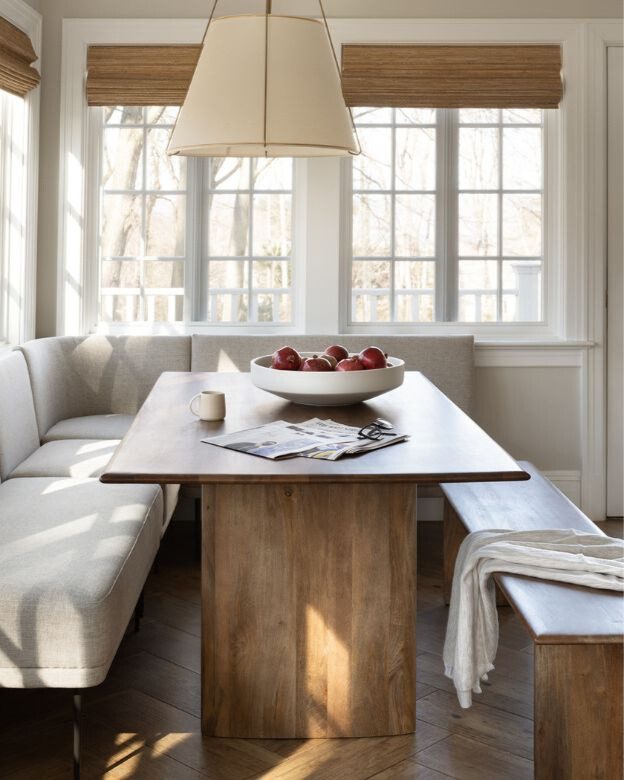

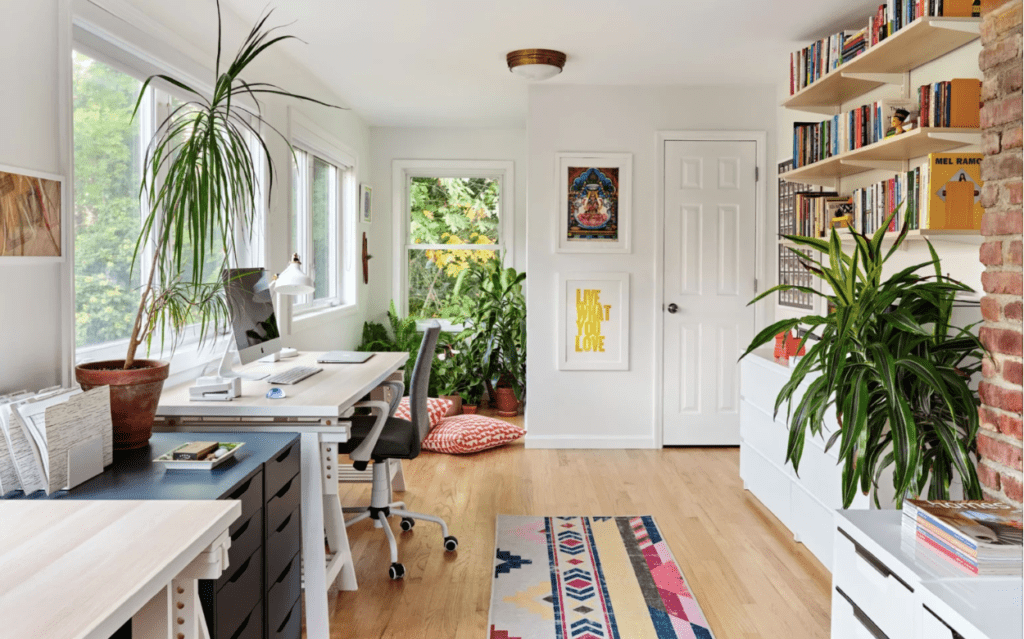

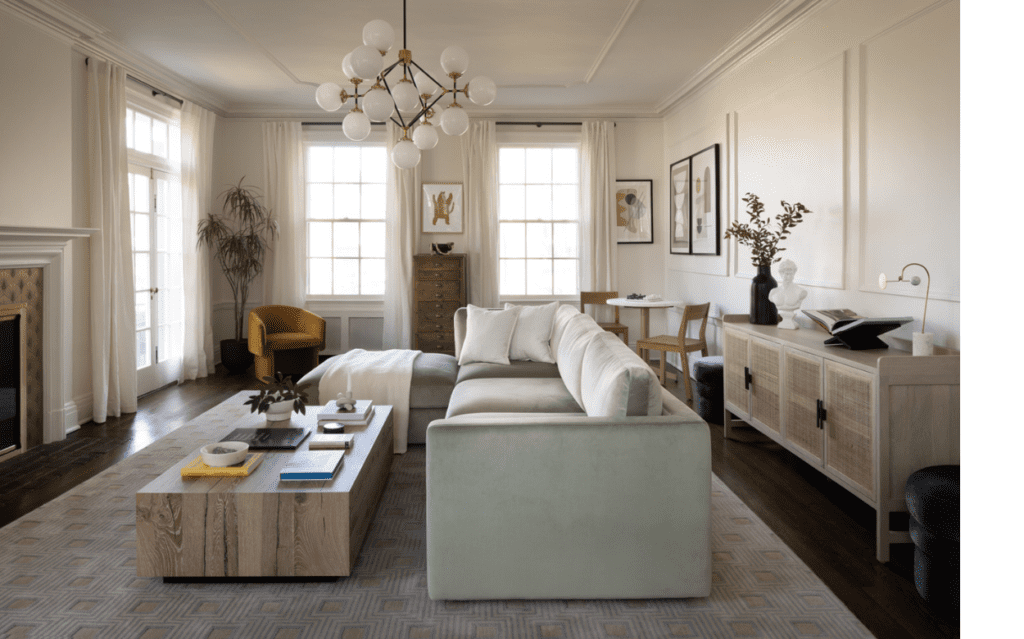

More holistic decorating tips and ideas
The expert tips, above, are the best starting place for considering a holistic perspective in your home. If you are ready for some extra credit, we’ve included a few additional ideas below.
1. Define your goals


It’s always a good first step to identifying your specific goals for your home. Consider what aspects of holistic design are most important to you, such as health and well-being, sustainability, mindfulness, or personalization. Understanding your priorities will guide your design decisions.
2. Use eco-friendly materials


Choose sustainable and non-toxic materials for your home. Opt for materials like reclaimed wood, bamboo, recycled glass, and low-VOC (volatile organic compounds) paints and finishes. These choices can improve indoor air quality and reduce your environmental impact.
3. Maximize natural light


As Gala Magriñá mentioned above, natural light is so important to our mood and well-being. In addition to making sure you’re getting plenty of light through well-placed windows, you can also consider using light colors and reflective surfaces to distribute light more effectively throughout your space..
4. Incorporate natural elements


Bring the outdoors inside by incorporating plants, stone, wood, and water features into your design. These elements can create a sense of connection to nature and a calming atmosphere. Bonus, many of these are also eco-friendly.
5. Promote energy flow


Arrange furniture and design elements to encourage easy movement within your space. Use principles of feng shui or other similar systems to create a harmonious and balanced environment.
6. Mindful decoration


Choose decor that resonates with you on a personal level and helps you be present. Art, decor, and objects that hold personal meaning or reflect your values can create a sense of well-being and comfort. Afterall, being surrounded by the things that make you uniquely happy is bound to improve your well-being.
7. Zones for specific activities


If you can, design your home to support different activities and functions like relaxation, work, exercise, and socializing. The idea is that this will help you maintain a balanced lifestyle.
8. Consider air quality


Invest in air purifiers, humidifiers, and plants that improve indoor air quality. And, as mentioned above, be mindful of the toxicity of the things you bring into your home such as furniture, textiles, paint, and other finishes that could negatively affect your home’s air quality.
9. Optimize ergonomics


Choose furniture and arrangements that promote good posture and comfort. This is especially important for workspaces and areas where you spend a lot of time.
10. Embrace slow


Perhaps the hardest step for many of us, remember that incorporating holistic interior design principles is a process that can evolve over time. Start with the aspects that are most important to you and gradually make changes as your budget and resources allow.
11. Seek professional guidance


If you're unsure about how to apply holistic design principles effectively, consider a consultation or full design project with an interior designer or architect who specializes in holistic or sustainable design. Our directory of sustainable interior designers is a great place to start!
Overall, holistic interior design aims to create spaces that are not only aesthetically pleasing but also promote well-being, health, and a sense of harmony for the people who inhabit them. It takes a more comprehensive and thoughtful approach to design, considering the physical, emotional, and psychological aspects of the users' experience within the space but it can be well worth it in what you get in return. We hope our article encourages you to give some holistic interior design principles a try in your own home!


FAQs about holistic interior design
What is energy flow in interior design?
The idea of energy flow in interior design can be a little abstract. Essentially, those who focus on this aspect of interior design believe there are intangible elements within a room's design that can make it a feel more positive or negative. Over time, practitioners of this idea have developed principles that optimize this positive feeling or energy.
This concept is often associated with holistic interior design and feng shui principles, which emphasize the importance of harmonious and balanced energy within an environment. The idea is that a well-designed space should allow energy, or chi (in the context of feng shui), to flow smoothly and freely, promoting a positive and harmonious atmosphere.
Interior designers who specialize in energy flow within design will often focus on the following areas:
Feng Shui
Feng shui, as mentioned above, is a Chinese practice that places a strong emphasis on energy flow within a space. It involves arranging furniture, and objects, and selecting colors in a way that promotes the free flow of chi, which is believed to influence one's well-being and life experiences.
Clear paths
Energy flow requires clear and unobstructed paths within a room. Furniture should be arranged to allow for easy movement, and clutter should be minimized to prevent stagnant or blocked energy.
Balancing elements
A balanced distribution of the five elements—wood, fire, earth, metal, and water—is often recommended in feng shui to maintain equilibrium and healthy energy flow. For example, incorporating wooden and water elements can balance the more active and fiery energy.
Natural light and ventilation
Good energy flow is often associated with spaces that have ample natural light and proper ventilation. This can create a sense of vitality and freshness.
Color and materials
Here, the idea is that the choice of colors and materials in a room can influence the energy of the space.
It's important to note that beliefs about energy flow in interior design are deeply rooted in cultural and philosophical traditions, such as feng shui. While some people may follow these principles closely, others may approach interior design from a more Western and functional perspective. The effectiveness of energy flow principles in interior design can vary depending on individual beliefs and cultural context, but they are an important consideration for those who value a holistic and balanced living environment.
While on its face, considering the energy of a room can feel a little abstract, when broken down into its areas of focus, many principles feel intuitively accurate. Natural light, airflow, and unobstructed, tidy rooms are all things that make a lot of people feel at ease. And the use of color has long been shown to influence moods and behaviors.
What’s the difference between holistic interior design and feng shui?
Holistic interior design can incorporate principles of feng shui, but it is not limited to feng shui. Feng shui is a traditional Chinese practice that focuses on the arrangement of objects and spaces to promote harmony, balance, and positive energy flow. While it is one approach to creating a harmonious living environment, holistic interior design encompasses a broader range of considerations, including health, sustainability, mindfulness, and personalization.
Holistic interior design seeks to create spaces that support the well-being of the occupants on physical, emotional, and psychological levels. This may involve using eco-friendly materials, optimizing natural light, incorporating natural elements, promoting good indoor air quality, and considering the psychological and emotional impact of design choices. While feng shui can be a part of this approach, it is just one of many tools that can be used to achieve a holistic living environment.
In practice, some individuals and interior designers may choose to integrate feng shui principles into their holistic interior design to enhance the overall harmony and balance of a space. However, it is not a requirement, and holistic design allows for flexibility in incorporating various design principles to create a personalized and well-rounded living environment.
What are EMFs and geopathic stress? How are they related to holistic interior design?
EMF stands for electromagnetic fields which are physical fields produced by electrically charged objects like ionizing radiation, such as x-rays, and non-ionizing radiation, like microwaves and wireless devices. While ionizing sources of EMFs have long been proven to cause damage to living tissues, the impacts of non-ionizing sources are a subject of ongoing research.
Geopathic stress refers to the idea that certain sources of natural radiation can have negative effects on human.. This concept is often associated with the belief that underground geopathic abnormalities such as water veins, fault lines, and certain mineral deposits can contribute to these stressors.
While scientific evidence of the impacts of these types of stressors is currently limited, for people with concerns about the impacts of these phenomena on their health, a holistic interior designer can help with solutions to counteract potential impacts. These can include things from the layout of your home to use of specific materials.
Other articles you may enjoy
Free tips and inspiration in your inbox
Enter your email address below to receive the latest news from The Home Green.

